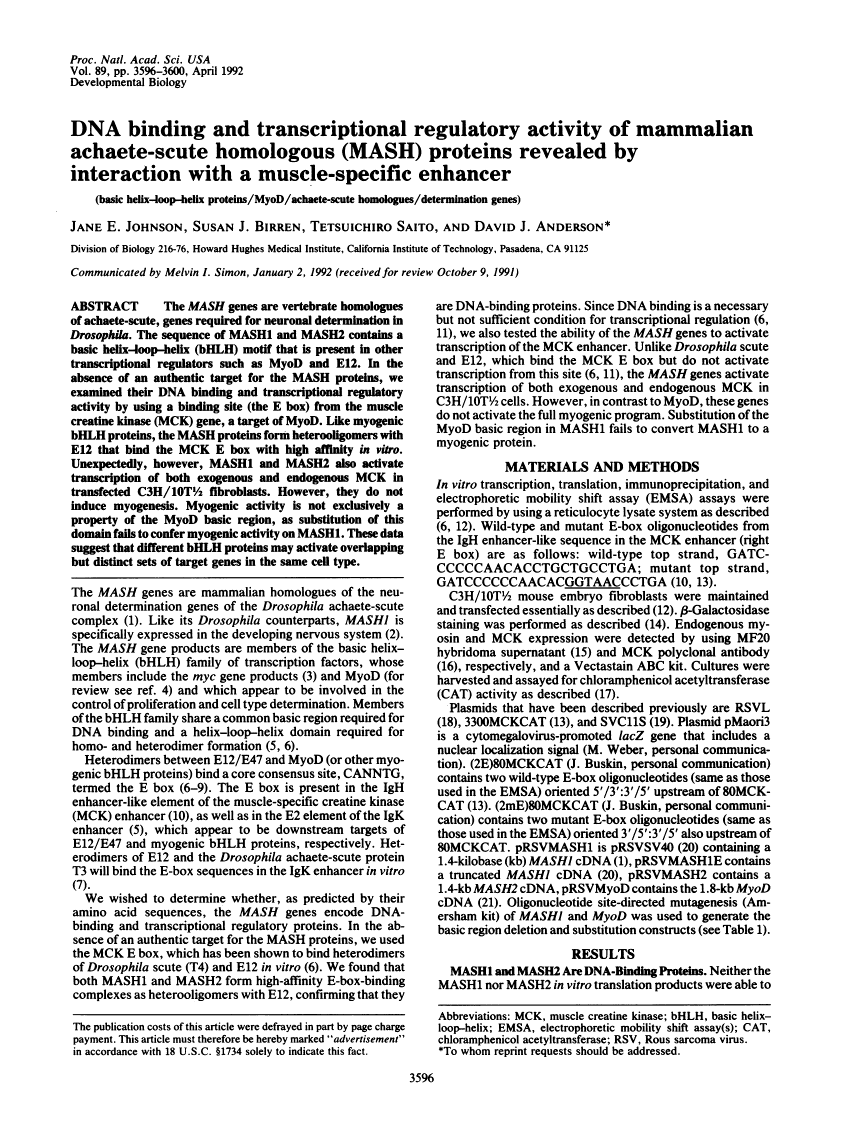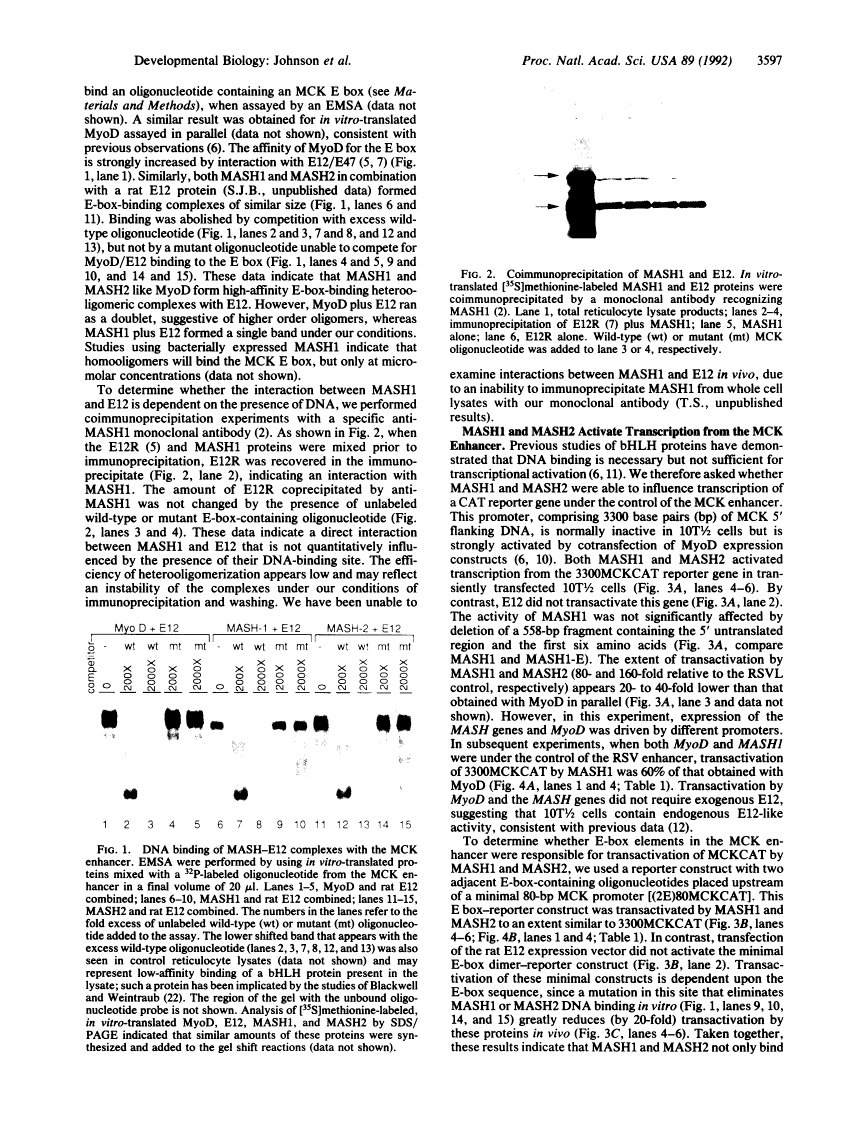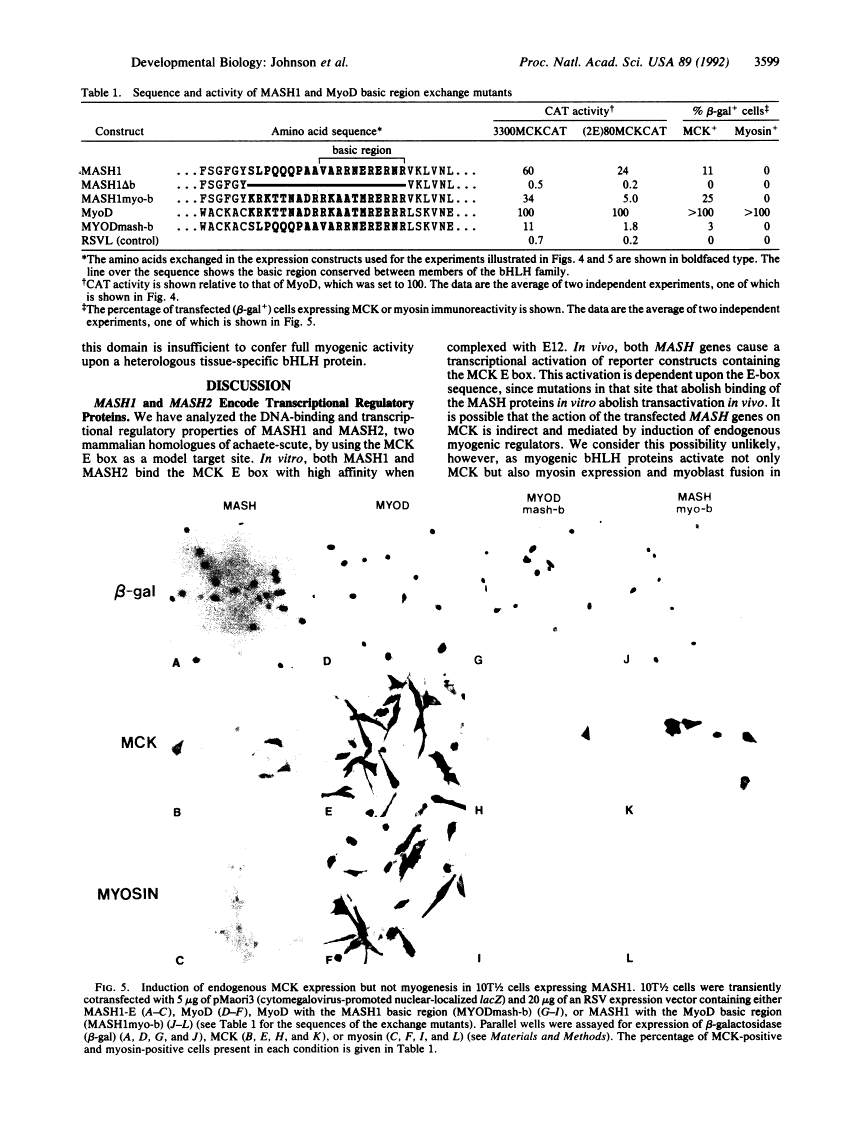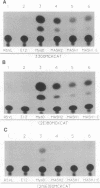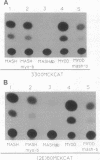Abstract
Free full text

DNA binding and transcriptional regulatory activity of mammalian achaete-scute homologous (MASH) proteins revealed by interaction with a muscle-specific enhancer.
Abstract
The MASH genes are vertebrate homologues of achaete-scute, genes required for neuronal determination in Drosophila. The sequence of MASH1 and MASH2 contains a basic helix-loop-helix (bHLH) motif that is present in other transcriptional regulators such as MyoD and E12. In the absence of an authentic target for the MASH proteins, we examined their DNA binding and transcriptional regulatory activity by using a binding site (the E box) from the muscle creatine kinase (MCK) gene, a target of MyoD. Like myogenic bHLH proteins, the MASH proteins form heterooligomers with E12 that bind the MCK E box with high affinity in vitro. Unexpectedly, however, MASH1 and MASH2 also activate transcription of both exogenous and endogenous MCK in transfected C3H/10T1/2 fibroblasts. However, they do not induce myogenesis. Myogenic activity is not exclusively a property of the MyoD basic region, as substitution of this domain fails to confer myogenic activity on MASH1. These data suggest that different bHLH proteins may activate overlapping but distinct sets of target genes in the same cell type.
Full text
Full text is available as a scanned copy of the original print version. Get a printable copy (PDF file) of the complete article (1.6M), or click on a page image below to browse page by page. Links to PubMed are also available for Selected References.
Images in this article
Click on the image to see a larger version.
Selected References
These references are in PubMed. This may not be the complete list of references from this article.
- Johnson JE, Birren SJ, Anderson DJ. Two rat homologues of Drosophila achaete-scute specifically expressed in neuronal precursors. Nature. 1990 Aug 30;346(6287):858–861. [Abstract] [Google Scholar]
- Lo LC, Johnson JE, Wuenschell CW, Saito T, Anderson DJ. Mammalian achaete-scute homolog 1 is transiently expressed by spatially restricted subsets of early neuroepithelial and neural crest cells. Genes Dev. 1991 Sep;5(9):1524–1537. [Abstract] [Google Scholar]
- Lüscher B, Eisenman RN. New light on Myc and Myb. Part I. Myc. Genes Dev. 1990 Dec;4(12A):2025–2035. [Abstract] [Google Scholar]
- Weintraub H, Davis R, Tapscott S, Thayer M, Krause M, Benezra R, Blackwell TK, Turner D, Rupp R, Hollenberg S, et al. The myoD gene family: nodal point during specification of the muscle cell lineage. Science. 1991 Feb 15;251(4995):761–766. [Abstract] [Google Scholar]
- Murre C, McCaw PS, Baltimore D. A new DNA binding and dimerization motif in immunoglobulin enhancer binding, daughterless, MyoD, and myc proteins. Cell. 1989 Mar 10;56(5):777–783. [Abstract] [Google Scholar]
- Davis RL, Cheng PF, Lassar AB, Weintraub H. The MyoD DNA binding domain contains a recognition code for muscle-specific gene activation. Cell. 1990 Mar 9;60(5):733–746. [Abstract] [Google Scholar]
- Murre C, McCaw PS, Vaessin H, Caudy M, Jan LY, Jan YN, Cabrera CV, Buskin JN, Hauschka SD, Lassar AB, et al. Interactions between heterologous helix-loop-helix proteins generate complexes that bind specifically to a common DNA sequence. Cell. 1989 Aug 11;58(3):537–544. [Abstract] [Google Scholar]
- Braun T, Winter B, Bober E, Arnold HH. Transcriptional activation domain of the muscle-specific gene-regulatory protein myf5. Nature. 1990 Aug 16;346(6285):663–665. [Abstract] [Google Scholar]
- Brennan TJ, Olson EN. Myogenin resides in the nucleus and acquires high affinity for a conserved enhancer element on heterodimerization. Genes Dev. 1990 Apr;4(4):582–595. [Abstract] [Google Scholar]
- Lassar AB, Buskin JN, Lockshon D, Davis RL, Apone S, Hauschka SD, Weintraub H. MyoD is a sequence-specific DNA binding protein requiring a region of myc homology to bind to the muscle creatine kinase enhancer. Cell. 1989 Sep 8;58(5):823–831. [Abstract] [Google Scholar]
- Weintraub H, Dwarki VJ, Verma I, Davis R, Hollenberg S, Snider L, Lassar A, Tapscott SJ. Muscle-specific transcriptional activation by MyoD. Genes Dev. 1991 Aug;5(8):1377–1386. [Abstract] [Google Scholar]
- Benezra R, Davis RL, Lockshon D, Turner DL, Weintraub H. The protein Id: a negative regulator of helix-loop-helix DNA binding proteins. Cell. 1990 Apr 6;61(1):49–59. [Abstract] [Google Scholar]
- Jaynes JB, Johnson JE, Buskin JN, Gartside CL, Hauschka SD. The muscle creatine kinase gene is regulated by multiple upstream elements, including a muscle-specific enhancer. Mol Cell Biol. 1988 Jan;8(1):62–70. [Europe PMC free article] [Abstract] [Google Scholar]
- Price J, Turner D, Cepko C. Lineage analysis in the vertebrate nervous system by retrovirus-mediated gene transfer. Proc Natl Acad Sci U S A. 1987 Jan;84(1):156–160. [Europe PMC free article] [Abstract] [Google Scholar]
- Bader D, Masaki T, Fischman DA. Immunochemical analysis of myosin heavy chain during avian myogenesis in vivo and in vitro. J Cell Biol. 1982 Dec;95(3):763–770. [Europe PMC free article] [Abstract] [Google Scholar]
- Chamberlain JS, Jaynes JB, Hauschka SD. Regulation of creatine kinase induction in differentiating mouse myoblasts. Mol Cell Biol. 1985 Mar;5(3):484–492. [Europe PMC free article] [Abstract] [Google Scholar]
- Gorman CM, Moffat LF, Howard BH. Recombinant genomes which express chloramphenicol acetyltransferase in mammalian cells. Mol Cell Biol. 1982 Sep;2(9):1044–1051. [Europe PMC free article] [Abstract] [Google Scholar]
- de Wet JR, Wood KV, DeLuca M, Helinski DR, Subramani S. Firefly luciferase gene: structure and expression in mammalian cells. Mol Cell Biol. 1987 Feb;7(2):725–737. [Europe PMC free article] [Abstract] [Google Scholar]
- Miner JH, Wold BJ. c-myc inhibition of MyoD and myogenin-initiated myogenic differentiation. Mol Cell Biol. 1991 May;11(5):2842–2851. [Europe PMC free article] [Abstract] [Google Scholar]
- Johnson JE, Zimmerman K, Saito T, Anderson DJ. Induction and repression of mammalian achaete-scute homologue (MASH) gene expression during neuronal differentiation of P19 embryonal carcinoma cells. Development. 1992 Jan;114(1):75–87. [Abstract] [Google Scholar]
- Davis RL, Weintraub H, Lassar AB. Expression of a single transfected cDNA converts fibroblasts to myoblasts. Cell. 1987 Dec 24;51(6):987–1000. [Abstract] [Google Scholar]
- Blackwell TK, Weintraub H. Differences and similarities in DNA-binding preferences of MyoD and E2A protein complexes revealed by binding site selection. Science. 1990 Nov 23;250(4984):1104–1110. [Abstract] [Google Scholar]
- Van Doren M, Ellis HM, Posakony JW. The Drosophila extramacrochaetae protein antagonizes sequence-specific DNA binding by daughterless/achaete-scute protein complexes. Development. 1991 Sep;113(1):245–255. [Abstract] [Google Scholar]
- Miner JH, Wold B. Herculin, a fourth member of the MyoD family of myogenic regulatory genes. Proc Natl Acad Sci U S A. 1990 Feb;87(3):1089–1093. [Europe PMC free article] [Abstract] [Google Scholar]
- Gossett LA, Kelvin DJ, Sternberg EA, Olson EN. A new myocyte-specific enhancer-binding factor that recognizes a conserved element associated with multiple muscle-specific genes. Mol Cell Biol. 1989 Nov;9(11):5022–5033. [Europe PMC free article] [Abstract] [Google Scholar]
- Mar JH, Ordahl CP. M-CAT binding factor, a novel trans-acting factor governing muscle-specific transcription. Mol Cell Biol. 1990 Aug;10(8):4271–4283. [Europe PMC free article] [Abstract] [Google Scholar]
- Lassar AB, Davis RL, Wright WE, Kadesch T, Murre C, Voronova A, Baltimore D, Weintraub H. Functional activity of myogenic HLH proteins requires hetero-oligomerization with E12/E47-like proteins in vivo. Cell. 1991 Jul 26;66(2):305–315. [Abstract] [Google Scholar]
- Chakraborty T, Brennan TJ, Li L, Edmondson D, Olson EN. Inefficient homooligomerization contributes to the dependence of myogenin on E2A products for efficient DNA binding. Mol Cell Biol. 1991 Jul;11(7):3633–3641. [Europe PMC free article] [Abstract] [Google Scholar]
- Tapscott SJ, Davis RL, Thayer MJ, Cheng PF, Weintraub H, Lassar AB. MyoD1: a nuclear phosphoprotein requiring a Myc homology region to convert fibroblasts to myoblasts. Science. 1988 Oct 21;242(4877):405–411. [Abstract] [Google Scholar]
Associated Data
Articles from Proceedings of the National Academy of Sciences of the United States of America are provided here courtesy of National Academy of Sciences
Full text links
Read article at publisher's site: https://doi.org/10.1073/pnas.89.8.3596
Read article for free, from open access legal sources, via Unpaywall:
https://europepmc.org/articles/pmc48915?pdf=render
Citations & impact
Impact metrics
Citations of article over time
Alternative metrics
Article citations
Inhibition of Karyopherin β1-Mediated Nuclear Import Disrupts Oncogenic Lineage-Defining Transcription Factor Activity in Small Cell Lung Cancer.
Cancer Res, 82(17):3058-3073, 01 Sep 2022
Cited by: 5 articles | PMID: 35748745 | PMCID: PMC9444950
Genetic Regulation of Vertebrate Forebrain Development by Homeobox Genes.
Front Neurosci, 16:843794, 25 Apr 2022
Cited by: 14 articles | PMID: 35546872 | PMCID: PMC9081933
Review Free full text in Europe PMC
Homodimeric and Heterodimeric Interactions among Vertebrate Basic Helix-Loop-Helix Transcription Factors.
Int J Mol Sci, 22(23):12855, 28 Nov 2021
Cited by: 12 articles | PMID: 34884664 | PMCID: PMC8657788
Review Free full text in Europe PMC
Physical interactions between Gsx2 and Ascl1 balance progenitor expansion versus neurogenesis in the mouse lateral ganglionic eminence.
Development, 147(7):dev185348, 10 Apr 2020
Cited by: 13 articles | PMID: 32122989 | PMCID: PMC7157596
A molecular mechanism of mouse placental spongiotrophoblast differentiation regulated by prolyl oligopeptidase.
Zygote, 27(1):49-53, 04 Feb 2019
Cited by: 1 article | PMID: 30714556
Go to all (80) article citations
Data
Similar Articles
To arrive at the top five similar articles we use a word-weighted algorithm to compare words from the Title and Abstract of each citation.
Different E-box regulatory sequences are functionally distinct when placed within the context of the troponin I enhancer.
Nucleic Acids Res, 20(19):5105-5113, 01 Oct 1992
Cited by: 23 articles | PMID: 1329039 | PMCID: PMC334291
MyoD and achaete-scute: 4-5 amino acids distinguishes myogenesis from neurogenesis.
Princess Takamatsu Symp, 20:267-278, 01 Jan 1989
Cited by: 5 articles | PMID: 2562185
A novel myogenic regulatory circuit controls slow/cardiac troponin C gene transcription in skeletal muscle.
Mol Cell Biol, 14(3):1870-1885, 01 Mar 1994
Cited by: 64 articles | PMID: 8114720 | PMCID: PMC358545
Activation of muscle-specific transcription by myogenic helix-loop-helix proteins.
Symp Soc Exp Biol, 46:331-341, 01 Jan 1992
Cited by: 18 articles | PMID: 1341046
Review
